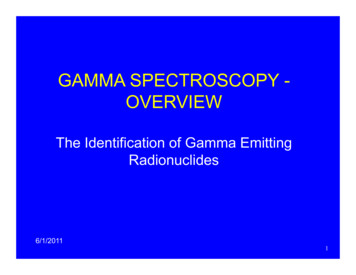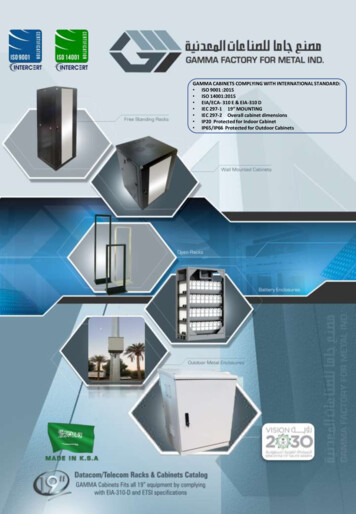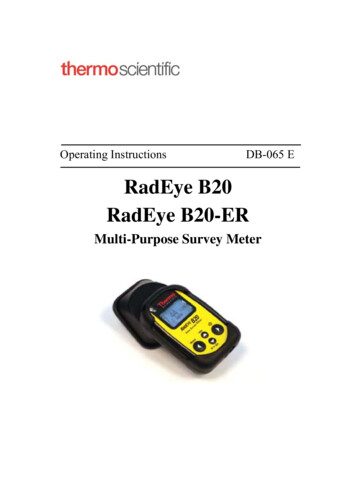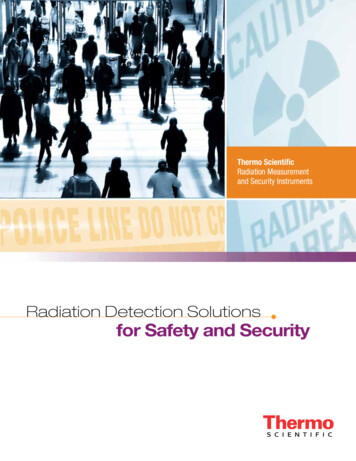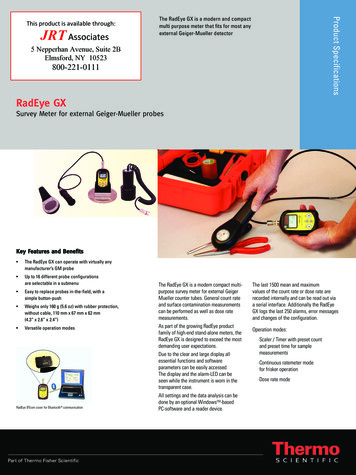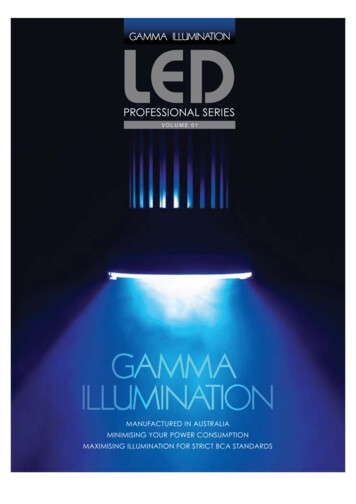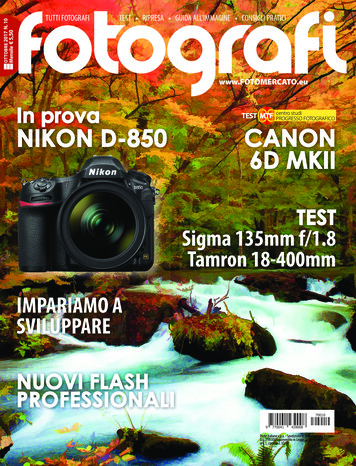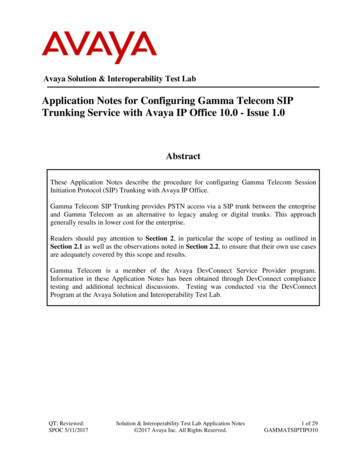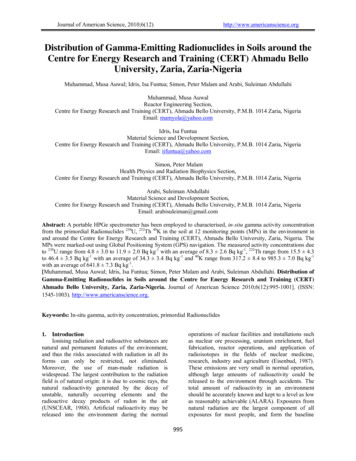
Transcription
Journal of American Science, on of Gamma-Emitting Radionuclides in Soils around theCentre for Energy Research and Training (CERT) Ahmadu BelloUniversity, Zaria, Zaria-NigeriaMuhammad, Musa Auwal; Idris, Isa Funtua; Simon, Peter Malam and Arabi, Suleiman AbdullahiMuhammad, Musa AuwalReactor Engineering Section,Centre for Energy Research and Training (CERT), Ahmadu Bello University, P.M.B. 1014 Zaria, NigeriaEmail: mamyola@yahoo.comIdris, Isa FuntuaMaterial Science and Development Section,Centre for Energy Research and Training (CERT), Ahmadu Bello University, P.M.B. 1014 Zaria, NigeriaEmail: iifuntua@yahoo.comSimon, Peter MalamHealth Physics and Radiation Biophysics Section,Centre for Energy Research and Training (CERT), Ahmadu Bello University, P.M.B. 1014 Zaria, NigeriaArabi, Suleiman AbdullahiMaterial Science and Development Section,Centre for Energy Research and Training (CERT), Ahmadu Bello University, P.M.B. 1014 Zaria, NigeriaEmail: arabisuleiman@gmail.comAbstract: A portable HPGe spectrometer has been employed to characterised, in-situ gamma activity concentrationfrom the primordial Radionuclides 238U, 232Th 40K in the soil at 12 monitoring points (MPs) in the environment inand around the Centre for Energy Research and Training (CERT), Ahmadu Bello University, Zaria, Nigeria. TheMPs were marked-out using Global Positioning System (GPS) navigation. The measured activity concentrations dueto 238U range from 4.8 3.0 to 11.9 2.0 Bq kg-1 with an average of 8.3 2.6 Bq kg-1, 232Th range from 15.5 4.3to 46.4 3.5 Bq kg-1 with an average of 34.3 3.4 Bq kg-1 and 40K range from 317.2 8.4 to 985.3 7.0 Bq kg-1with an average of 641.8 7.3 Bq kg-1.[Muhammad, Musa Auwal; Idris, Isa Funtua; Simon, Peter Malam and Arabi, Suleiman Abdullahi. Distribution ofGamma-Emitting Radionuclides in Soils around the Centre for Energy Research and Training (CERT)Ahmadu Bello University, Zaria, Zaria-Nigeria. Journal of American Science 2010;6(12):995-1001]. (ISSN:1545-1003). http://www.americanscience.org.Keywords: In-situ gamma, activity concentration, primordial Radionuclidesoperations of nuclear facilities and installations suchas nuclear ore processing, uranium enrichment, fuelfabrication, reactor operations, and application ofradioisotopes in the fields of nuclear medicine,research, industry and agriculture (Eisenbud, 1987).These emissions are very small in normal operation,although large amounts of radioactivity could bereleased to the environment through accidents. Thetotal amount of radioactivity in an environmentshould be accurately known and kept to a level as lowas reasonably achievable (ALARA). Exposures fromnatural radiation are the largest component of allexposures for most people, and form the baseline1.IntroductionIonising radiation and radioactive substances arenatural and permanent features of the environment,and thus the risks associated with radiation in all itsforms can only be restricted, not eliminated.Moreover, the use of man-made radiation iswidespread. The largest contribution to the radiationfield is of natural origin: it is due to cosmic rays, thenatural radioactivity generated by the decay ofunstable, naturally occurring elements and theradioactive decay products of radon in the air(UNSCEAR, 1988). Artificial radioactivity may bereleased into the environment during the normal995
Journal of American Science, 2010;6(12)http://www.americanscience.orgupon which exposures from manmade sources areadded (UNSCEAR, 2000).Gamma-ray spectroscopy system providespractical way to characterize dispersed Radionuclidesin or on the soil to ascertain possible changes in theenvironmental radioactivity. Both laboratory and insitu gamma spectroscopy are often used formonitoring and assessment of radioactivity andradiation dose rates in the environment due to bothnatural and anthropogenic sources. (Beck et al., 1972;Nikl et al., 1988; ICRU, 1994; Othman et al., 1994;Tzortzis et al., 2003; Clouvas et al., 2004).In largescale environmental radioactivity measurement, insitu gamma spectroscopy is much favoured comparedto laboratory soil analysis because of time andproblems associated in cross contamination involvedin the laboratory methods. It also gives theopportunity to obtain information not only of theactivity concentration but also of the relativecontribution of the various nuclides to activityconcentration. In-situ techniques for measuring theactivity concentration, resulting from the gammaradiation and characterizing its sources, with gammaray spectrometer have been used successfully in theoutdoor environment (Beck et al., 1972; Clouvas etal., 2001; Petalas et al., 2005; Auwal,M.M. 2005)For radiation monitoring near nuclearfacilities, baseline data, are indispensable for variouspurposes: they provide documented reference base;for the assessment of actual or potential consequenceof radioactivity on health, and on the environment,due to radioactive materials or radiation fields in theenvironment from normal operations and accidentalreleases. The present work has been conducted in theCentre for Energy Research and Training (CERT),and some selected settlements within 2km radiusfrom NIRR-1, using high-resolution portable gammaspectrometry system. The Centre is a nuclear energy(radiation) based research centre, thus, dealing withsubstantial quantities of artificial radioactivematerials, such as neutron generator, Am-Be isotopicneutron source, a nuclear research reactor codenamed Nigeria Research Reactor-1 (NIRR-1); amongothers.The present work puts forward a systematicmethod for determining environmental activityconcentrations levels from in-situ measurements, andshows the distribution and intensities of importantnatural and artificial radionuclides within the studiedarea. It complements previous studies reported byother authors (Ibeanu et al., 2002) by providing insitu gamma spectrometry based, baseline data, foroperational and post operational monitoring, of theCentre for Energy Research and Training (CERT).2. Materials and Methods2.1 SiteThe study site is located at 007o38.523’–o007 40.822’E and 11o07.830’–11o09.790’ N withinthe Zaria sheet 102.The number of monitoring points(MPs) includes; eight locations within the Centre forEnergy Research and Training (CERT), AhmaduBello University, Zaria, and four other locations atselected settlements around CERT within 2Kmradius. Table 1 gives the description of themonitoring points (MP) with respect to the NigeriaResearch Reactor 1 (NIRR1) as reference point. Thechosen sites were undisturbed with little or no surfacefeatures and modest vegetation. These sites weremarked-out using Global Positioning System (GPS).2.2 Gamma-ray Detection systemThe experimental set-up is a stand-alone highresolution spectroscopic system used for the in-situmeasurement of the energy spectrum of the emittedgamma rays in the energy range between 50 keV and3000 keV. The system consist of a high-puritygermanium (HPGe) detector EG & G ORTEC coaxial cylinder of crystal length of 46.8 mm anddiameter 55.0 mm, with an efficiency of 23.5% 272relative to a 7.6 x 7.6 cm NaI(Tl) crystal. In addition,energy resolution (FWHM) of 2.0 keV was achieved,all for a 60Co emission point source at 25 cm for 1.33MeV. This type of detector can sustain warm upwhen not in use, which is a convenient feature duringextended field trips. The detector was mounted on aportable (hand-held) 10 litres liquid nitrogen Dewarthat features an all attitude capability. Liquid nitrogenwas used for cooling the detector during operation.After filling the portable Dewar with liquid nitrogen,it requires a 6 hour cool-down time before becomingoperational with 24 hours nominal holding time. Thedetector assembly was mounted on a 1 m tripod withthe crystal end cap facing down towards the groundand the Dewar above. This orientation maximizes theflux that will be intercepted and registered by thedetector (Kelvin, 1997). The detector unit wasconnected to a battery powered EG & G ORTEC “NormadPlus”portablecomputerbasedspectroscopy system. High voltage and preamplifierpower were supplied to the detector by the system.An advanced multi-channel analyzer (MCA)emulsion software (MAEASTRO-32) was used fordata acquisition, storage display and analysis, of theacquired gamma-spectra.996
Journal of American Science, 2010;6(12)http://www.americanscience.orgFigure 1: Typical in situ g-ray detection system at one of the monitoring points (MP) the 295, 352, 609, 1120 and 1765 keV peaksin the 238U series, the 238, 510, 583, 911, 965 and 2615 keVpeaks in the 232Th series, the 1460 keV peak of 40K.2.3In-situ measurement and analysisThe current study was conducted in themonths of May and June 2005. The fieldmeasurement of terrestrial gamma radiation wasbased on the assumption that there exist laterallyuniform distribution of natural Radionuclides in theenvironment and that the vertical contribution fromthe soil is limited to the first horizon ( 10cm to30cm). Measurements were performed over flatterrain; that allow source geometry to be representedas an infinite half-space; that is 2π geometry in termsof solid angle subtended by the source.The source measured was soil sample andcounting statistics for a given spectral absorptionpeak were obtained in a fraction of the time requiredfor counting a small collected sample. Measurementsof spectra in the field were made for a period of 5000s. However, series of random short readings of about600 sec were first taken, to ensure that, there isapproximate uniformity, consequently, the desiredcounting statistics. The measuring system wasroutinely checked with 137Cs and 60Co standardsources.A computer based multi-channel analyzersystem with emulsion software (MAESTRO–32) wasused for spectra acquisition. Based on two-pointenergy calibration as set for the operation, prominentpeaks were identified in a benchmark spectrum(fig.1d) and the appropriate regions of interest wereset up. These peaks, which are characteristics oftypical environmental spectra, are:The set energy bands define the peaks where theleft and right channel markers are representative ofthe Compton continuum.Detector’s specificcalibration factors (measured efficiency) determinedin an earlier experiment (Auwal, 2005), were appliedto convert from net peak count rate to activityconcentration. Only peaks with reasonable gammaray emission probabilities were considered.3. Results and discussionThe activity concentrations for 232Th, 238U and 40Kwith standard error of the measured locations arepresented in table 2, while table 3, show the statisticalanalysis of the results and percentage contribution isshown in figure 3. The activity concentrations werecalculated by the net peak areas of 511 keV (208Tl)and 911 keV (208Ac) for 232Th, 609 keV (214Bi) and352 keV (214Pb) for 238U, and 1460 keV for40K. Theconcentrations range from 15.5 4.3 to 46.4 3.5 Bqkg-1(34.3 3.4) for 232Th, 4.8 3 to 11.9 2 Bq kg-1(8.3 2.6) for 238U and 317.2 8.4 to 985.3 7 Bqkg-1 (684 7.3) for 40K with mean values enclosed inthe brackets. The relative contribution of the differentnatural gamma emitters (Thorium series, Uraniumseries, and 40K) to the total activity concentrationvary among the monitoring point. This range from997
Journal of American Science, 2010;6(12)http://www.americanscience.org3.3% to 8.3% for 232Th, 0.7% to 1.7% for 238U and90.2% to 95.5% for 40K .Of all the locations MP004and MP011 appear to have the highest concentrationof 232Th, also MP004 exhibits the highestconcentration of 238U. MP012 appear to have muchhigher concentration of 40K when compared with theconcentrations at other locations, with value of 985.3 7 Bq kg-1. In addition, the 232Th/238U ratios for thelocations range from 2.8 to 6.4. This shows uraniumis less than thorium by a factor of three.Table 1Site identification by Global Positioning System (GPS), and description of Monitoring PointsSite IDLocationLatitudeDescriptionLongitudeMP00111 08.439’N07 39.840’ECRMP07 about 5m from NIRR-1MP00211 08.426’N07 39.844’ECRMP08 about 105m from NIRR-1MP00311 08.476’N07 39.901’ECRMP05 about 141m from NIRR-1MP00411 08.497’N07 39.851’ECRMP06 about 100m from NIRR-1MP01111 08.415’N07 39.776’ECRMP03 about 140m from NIRR-1MP01211 08.358’N07 39.912’ECRMP04 about 220m from NIRR-1MP01311 08.505’N07 39.963’ECRMP01 about 280m from NIRR-1MP01411 08.549’N07 39.823’ECRMP02 about 220m from NIRR-1MP11111 07.830’N07 39.447’EBeside ABU DamMP11211 08.205’N07 40.186’ELEA Unguwam Jema'a a nearby settlementMP113MP11411 08.749’N11 09.790’N07 40.822’E07 38.524’EAviation site iiLEA Samaru a nearby settlementexcept for some of the 238U that were reported asbelow detection limit. On the other hand, 40K hasexhibited certain degree agreement between the tworesults, with a variation of approximately 5% atsome points.Comparing the activity concentrations of thepresent work with the Ibeanu et al., (2002), in whicha laboratory based NaI(Tl) detector was employed tomeasure the radionuclide concentrations in dry soilsamples from the same measurement points, the insitu measurement results for 232Th and 238U weregenerally significantly lower than the laboratory data,Table 2Activity concentration of 232Th, 238U and 40KConcentration Stat. Error (Bq kg-1)Site ID232Contr. (%)238Contr. (%)40Contr. (%)232TotalMP00121.1 2.53.37.5 2.81.2609.6 5.795.52.8638.2 9.6MP00245 3.55.511.9 2.01.5759.9 1093.03.8816.8 15.5MP00337.5 2.44.110 1.81.1868.4 694.83.8915.8 10.2MP00446.4 3.55.311.9 2.01.4809.9 1093.23.9868.1 15.5ThU998KTh/238U
Journal of American Science, 2010;6(12)http://www.americanscience.orgMP01146.2 2.96.810.5 2.51.5626.2 9.191.74.4682.9 14.5MP01245.9 3.64.47.2 1.80.7985.3 794.96.41038.5 12.4MP01332.1 5.36.17.2 3.81.4487.9 5.592.64.5527.1 14.6MP01430.9 3.35.96.4 2.51.2487.9 4.192.94.8525.2 9.9MP11131.1 3.16.58.34 2.91.7442 7.191.83.7481.5 13.1MP11236.8 2.94.49.6 2.41.2783.5 9.994.43.8829.9 16.2MP11315.5 4.34.64.8 3.01.4317 8.494.03.2337.2 15.7MP11441 3.58.37.5 2.91.5444 9.190.25.5492 14.5The reason for the difference may be mostlycoming from the type of detector used in each case,the accuracy of the response at the energies used inthe analyses, and the method of calibration.Moreover, soil moisture variation or actual variationin the dry concentration of radionuclides with depthis among the limiting factors for establishingcomparability between in-situ and soil samplemeasurement.Table 3Statistical data for activity concentration (Bq kg-1)NuclideMeanConfid. 038.5223.170.5ThUKTh/238UIt may be noted that in the in-situmeasurement, the detector samples the photon fluxfrom a volume of soil out to a radius ofapproximately 10 m and down to a depth of about 30cm, depending upon the photon energy (Kelvin,1997). Fig. 1.c shows a pictorial representation of therelative ground area contributions to the primary(uncollided) flux at a height of 1m for a mediumenergy (662keV) source with typical exponentialdepth profile in the soil. Thus, the activity that wascloser to the soil surface tends to produce a widerfield of view. In effect, a field spectrum samples anarea of several hundred square metres: averaging outthe local inhomogenities in the distribution of theRadionuclides.999
Journal of American Science, 2010;6(12)http://www.americanscience.orgFigure 2: A typical gamma-ray spectrum showing important identified photo-peaks and their associatedRadionuclidesthan the world median value while that of 238U islower than the corresponding world value; thus 238Uis less than the world value by a factor of three.However, 40K concentration appeared to be higherthan the world median value at all the points, exceptMP113 with value of 317 8.4 Bq kg-1 .The calculated activity mean values from thelocations were 34.3, 8.3 and 641.8 Bq kg-1 for 232Th,238U and 40K respectively. Correspondingly therevised median values worldwide (UNSCEAR, 2000)are 30, 35, and 400 Bq kq-1 respectively. This revealsthat the mean concentration level measured in theselected areas of Zaria for 232Th is slightly higher120100Contribution (%)806040232Th20238U40K0MP001MP002 MP003MP004MP011MP012 MP013MP014MP111MP112 MP113Monitoring PointsFigure 3: Percentage contribution of activity concentration1000MP114
Journal of American Science, 2010;6(12)http://www.americanscience.org4 ConclusionHigh-resolution gamma ray spectrometry wasexploited to determine distribution of gammaemitting Radionuclides in soils around the Centre forEnergy Research and Training, Ahmadu tions determined for 232Th, and 238U weresignificantly lower when compared with thosedetermined by laboratory based NaI(Tl) detectorsystem but in general agreement for 40K by bothtechniques. The mean activity concentrations werehigher than the revised world median values for232Th, and 40K and lower for 238U. This technique isuseful for operational and post operationalmonitoring for the Centre, which will serve asreference for present and future assessment. Theassessment of the radionuclide level of the area didnot detect the presence of any artificial radionuclideand thus no significant impact of the extensive usageof radioactive materials within and around the Centrethe on the radiation burden of the environment.4.5.6.7.8.AcknowledgementThe authors wish to express their gratitude to theCentre for Energy Research and Training, AhmaduBello University, Zaria for the support given to theentire project.9.Corresponding Author:Arabi Suleiman AbdullahiMaterial Science and Development Section,Centre for Energy Research and Training,Ahmadu Bello University, ZariaEmail: , M.M. Determination of Absorbed andEffective dose from Natural Background Radiationwith Portable HPGe Detector. M.Sc. thesis.Ahmadu Bello University, Zaria. 200.Beck, H. L., De Campo, J., Gogolak, C. In situGe(Li) and NaI(Tl) gamma-ray spectrometry .NewYork, US DOE, Environmental measurementLab., HASL-258. 1972.Clouvas, Xanthos, S., Antonopoulos-Domis, M.Extended survey of indoor and outdoor terrestrialgamma radiation in Greek Urban areas by in situgamma spectrometry with portable Ge detector.11/10/2010100112.13.Radiat. Prot. Dosim. Vol. 94, No. 3. 2001. pp.233-245.Clouvas, A., Xanthos, S., Antonopoulos-Domis,M. Radiological maps of outdoor and indoorgamma dose rates in Greek Urban areas obtainedby in situ gamma spectrometry. Radiat. ProtDosim Vol.112, No. 2, 2004.pp. 267-275.Eisenbud, M. Environmental radioactivity fromNatural, Industrial and Military Sources. (NewYork: Academic Press, Harcourt Brace Joanovich)1987.Ibeanu, I. G. E., Futua, I. I., Adeyemo, D. J,Bappah, A. I. and Umar, I. M. Radiationmonitoring programme for the Centre for EnergyResearch and Training (CERT) Nuclear researchreactor site and environs. Second technical reportof the Centre for Energy Research and Training(CERT), Ahmadu Bello University, Zaria.CERT/MNSR/RMP/02. 2000.International Commission on Radiation Units andMeasurements, ICRU Report 53 Gamma-RaySpectrometry in the Environment 1994.Bethesda, MD.Kelvin, M.M. (1997. Field GammaRay Spectrometry. Section 3, In EML ProcedureManual, HASL-300, 28th edHASL-300-ED.27-Vol1DOE, Environmental Measurement LaboratoryNew York (DE91- 10178).Nikl, I., Sztanyik, L. B. External indoor andoutdoor gamma exposures in Hungary duringthe period of 1983-86. Radiat. Prot. Dosim.Vol. 24(1/4), 1988.pp. 387-389.Othman, I. and Yassine, T. Natural radioactivityin the Syrian environment. Sci.of Tot. Environ.Vol.170, 1994.pp.119-124.11. Petalas,A. B.Vogiannis,E.Nikolopoulos, D. Halvadakis, C. P. Preliminarysurvey of outdoor gamma dose rates inLesvos Island (Greece). Radiat. Prot. Dosim. Vol.113, No. 3, 2000.pp. 336– 341.Tzortzis M., Tsertos H., Christofides S.,Christodoulides, G., Gamma-ray measurementsof naturally occurring radioactive samples fromCyprus characteristic geological rocks. Radiat.Measur.Vol.37, 2003.pp.221-229.UNSCEAR. United Nations Scientific Committeeon the effects of Atomic Radiation. Source andeffects of ionizing radiation. Report to GeneralAssembly, with Scientific Annexes, UnitedNations, New York, 2000.
Centre for Energy Research and Training (CERT), Ahmadu Bello University, P.M.B. 1014 Zaria, Nigeria . Email: arabisuleiman@gmail.com . Abstract: A portable HPGe spectrometer has been employed to characterised, in-situ gamma activity concentration from the primordial Radionuclides . 238. U, 232. Th . 40.
